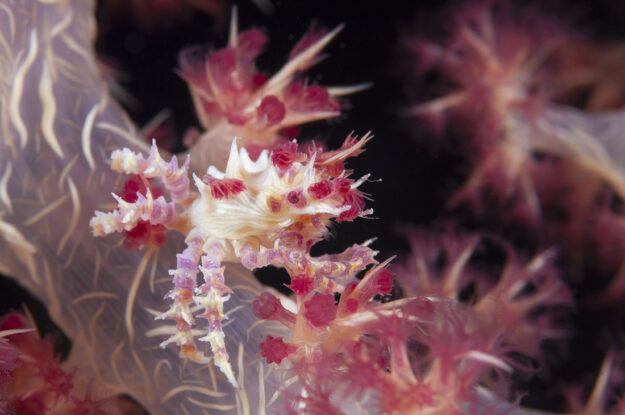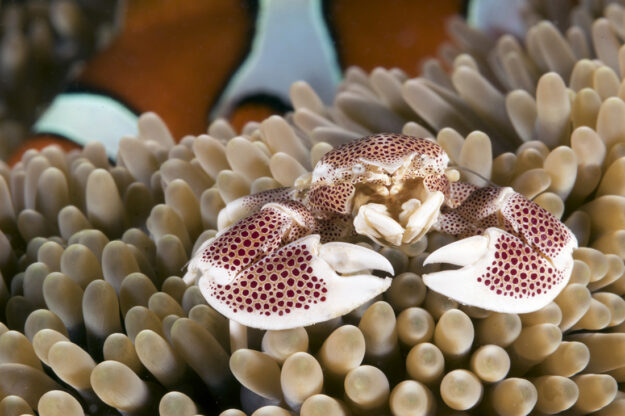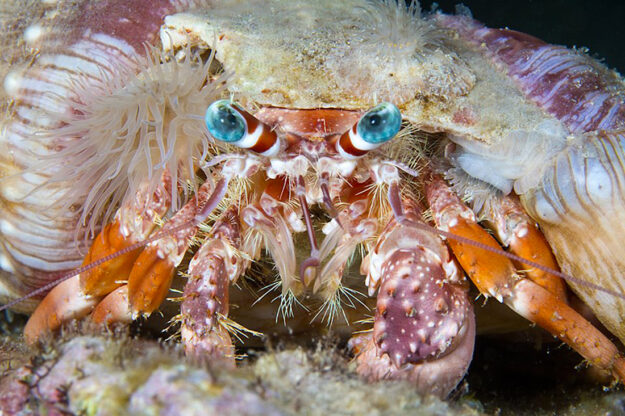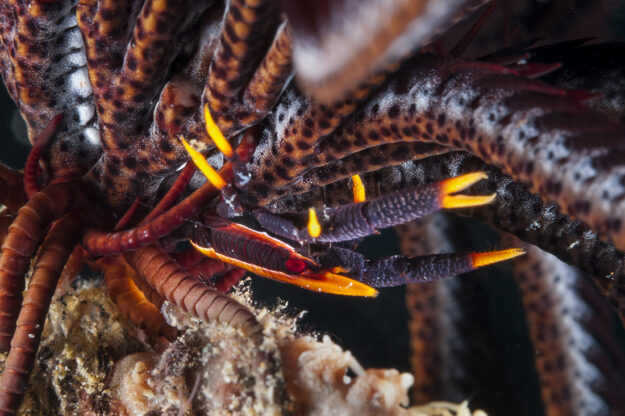Let’s Get Crabby
Discovering Wakatobi’s wild, weird and wonderful world of crabs
When you hear the word “crabby” it often means someone is not having a good day. But if you are exploring the reefs of Wakatobi, getting crabby can be a good thing, as it opens up a fascinating world of clawed crustaceans. And we’re not just talking about the scuttling, claw-clacking varieties you’ll see crab-walking sideways along the beach or through the shallows. Take a closer look, and you’ll discover all manners of small crustaceans occupying the reef, each with a unique strategy for survival.
A tiny cheerleader
A tiny cheerleader, the Pom Pom Crab is known for its signature trait of always carrying a small live sea anemone around in each claw, resembling pom-poms, which helps the crab catch food and protect itself from predators. Here’s a clip of a cute female Pom Pom crab, found at Buton Island during a dive from Pelagian Dive Yacht.
Going soft
It will take a keen eye to find a soft coral crab on Wakatobi’s reefs, not only because these diminutive crustaceans often measure a half-inch in length, but also because they are masters of disguise. They take their common name not from a weakness in their shell, but from their habit of homesteading on the branches of certain soft corals. The deception begins with the crab’s coloring and shape, both of which mimic the patterns and shadings of their coral host, in colors that can range from white to pink, yellow or red.

If the opportunity presents itself, look close at the soft coral crab and you may notice a pair of tiny claws on its front legs. Photo by Richard Smith
For an extra measure of camouflage, these crabs will also adorn their carapaces with polyps and branches harvested from the coral. Chances are, you won’t see a well-hidden soft coral crab unless it moves. When you do, look closely and you may notice a pair of small claws on the crab’s front legs. These aren’t used to gather food, as the crabs are plankton feeders, but instead, are used to provide the grip needed to gather and place the decorations harvested from their host. This strategy provides significant benefits to the crab, but none to the coral. It’s a relationship biologists identify as commensal, but what most of us would just call one-sided.
Natural cover
The soft coral crab isn’t the only species of crustacean in Wakatobi that uses bits and pieces of the surrounding landscape to create nature’s equivalent of a Ghillie suit. Collectively known as the decorator crabs, these small critters cover their bodies in everything from debris and algae to small bits of sponge to blend into their surroundings and avoid detection by predators. In some cases, they may employ a different strategy, intentionally covering themselves in colors that resemble a toxic animal, such as a nudibranch. Biologists would describe this as deceptive aposematism, otherwise known as false advertising.

Orangutan crabs may also be spotted on various types of corals and sponges, or sometimes out in the open on a patch of sand. Photo by Walt Stearns
One of the most fascinating decorator crabs you’ll find at Wakatobi is the orangutan crab, which employs yet another camouflage strategy. Rather than add a layer of debris, it cultivates a coating of orange, hair-like algae that resembles nothing so much as the fur of the jungle-dwelling primate of the same name. The resemblance is heightened by the crab’s elongated arms, which they may wave from side to side. Not all orangutan crabs sport a luxuriant covering of “fur” but when they do, the filaments often trap additional debris that help them blend into their surroundings. The most common place to find an orangutan crab at Wakatobi is on a patch of bubble coral, though they may also be spotted on other corals and sponges, or sometimes out in the open on a patch of sand.
Nemo’s roommates
Clownfish have long been a favorite of fish watchers and underwater photographers. But Nemo is not the only occupant hiding amidst the tentacles of an anemone. The diminutive porcelain anemone crab has developed its own strategy for living within an anemone’s poisonous embrace: the crab coats itself in the anemone’s own mucus, which switches off the host’s stinging reflex. This chemical deception provides the crab with the obvious benefit of protection from predators, but it’s also beneficial to the anemone, as the crab provides housekeeping services for its host by feeding on algae and small debris that become lodged among the tentacles.

Here you see Nemo himself photo-bombing this porcelain anemone crab’s portrait among the tentacles of a beige carpet anemone. Photo by Walt Stearns
Porcelain anemone crabs usually live in pairs, and sometimes share their space with clownfish and cleaner shrimp. On smaller anemones, where real estate is limited, some species of clownfish may displace the smaller critters. Larger anemones are more likely to play host an entire menagerie of symbiotic species. Knowing this may give critter hunters a hint as to which anemones on Wakatobi’s reefs are most likely to have the crabs. A good place to start is the section of reef directly under and around the resort’s Jetty Bar.

Hermit crabs use their claws to prod, scrape and tap an anemone until it loses its grip on the reef substrate. The crab then moves the anemone to its purloined shell, where it attaches itself and becomes a potentially painful deterrent to any predator. Photo by Walt Stearns
Chemical defenses
On Wakatobi’s reefs, certain types of crabs do more than just live within anemones–they put them to work. Hermit crabs have already figured out the shelter angle; they simply move into a discarded gastropod shell, which becomes their mobile armored dwelling. The anemone crab takes it one step further by adding an element of biological warfare to the armor. Working under the cover of darkness, this crab will scuttle along the reef, using it’s claws to prod, scrape and tap an anemone until it loses its grip on the reef substrate. The crab then moves the anemone to its purloined shell, where it attaches itself and becomes a potentially painful deterrent to any predator such as the small octopus that will try to extricate the crab from it’s shelter. When these crabs outgrow their current shells and move to a larger model, they will move their anemones with them.
Equally ingenious, and even more fun to watch are pom pom crabs, which is featured at the top of this page. These clever crustaceans cultivate a pair of tiny anemones on their claws, giving themselves the appearance of pom pom wielding cheerleaders that become especially vivid when the crab strikes a defensive position and begins waving the stinging anemones about as if leading the crowd in a half time cheer. It’s not exploitation, however, as the anemones benefit by gathering up food scraps as they are waved about.

Crinoid crabs affix themselves to the base of the crinoid; their colors and patterns allow them to blend splendidly with their host. Photo by Walt Stearns
Crabs choose a wide variety of habitats and hosts. Crinoid crabs affix themselves to the base of the crinoid; their colors and patterns allow them to blend splendidly with their host. The Thorny crinoid crab, for example, lives at the heart of only crinoids that emerge as darkness falls. The crinoids themselves are orange in color, which offers some camouflage in the low light levels underwater.
Having “the crabs” is more than just a saying at Wakatobi, as there are many, many species inhabiting our reefs and shallows. Some stay hidden, others scuttle through the shallows, or emerge after dark. As you learn about these fascinating creatures, you will begin to notice them on almost every dive or snorkel.
Isn’t it time to experience all the Wakatobi has to offer? Contact us at office@wakatobi.com, or complete a quick trip inquiry at wakatobi.com.


